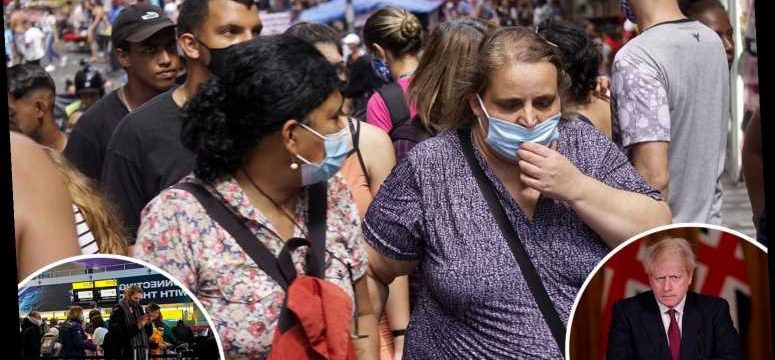THE mutant Covid strain currently sweeping across the UK was first spotted in Brazil eight months ago, scientists have revealed.
Studies have shown the mutation, known as N501Y, was first spotted in April before appearing in Australia and the US.
A mutation has occurred in the spike protein, the part of the virus that attaches itself to cells and causes illness, and the part targeted by the Covid-19 vaccines.
The N501Y variant is just one of 23 separate mutations in the new strain and government scientists believe it is this which gives it up to 70 per cent more efficiency, possibly concentrating the virus in the mouth and nose.
Advisers said the N501Y did not initially cause much alarm when it first appeared because it failed to rip through populations on its own.
But they now think the “constellation” of mutations in the new strain, possibly powered by N501Y, may well have caused the new strain’s increased infectivity.
Dr Julian Tang, Honorary Associate Professor/Clinical Virologist, University of Leicester, said: “At least two of the mutations in this new variant, N501Y (since at least Apr 2020 in Brazil) and 69-70del (since at least Jan/Feb 2020 in Thailand/Germany) were already circulating globally prior to combining into this new variant."
"When you put various mutations together, the combination can have a different effect," said Prof Peter Horby, the chairman of the Government's Nervtag advisory committee.
"Any single one of those may have been seen elsewhere, like N501Y, but this constellation of multiple mutations would appear to be very new."
Prof. Jacob Moran-Gilad, a medical specialist in clinical microbiology and public health from Ben-Gurion University’s School of Public Health, and a member of Israel’s Pandemic Management Team as warned the new variant could in the UK may be “just the tip of the iceberg.”
“While it has not yet been definitively proven that the strain is more infectious,” Moran-Gilan told the Jerusalem Post, “the numbers Boris Johnson presented on Saturday were a projection, based on data that shows a recent rise in infections in areas where this specific mutation was found.”
“The British are currently the world leaders in their rate of genetic sequencing for Covid-19 patient samples. That’s why they’re the ones that find these things. It’s very likely that what we are seeing in Britain is just the tip of the iceberg. There are most likely a lot of mutations we don’t yet know about because most of the world doesn’t consistently survey and track the mutation,” he said.
Scientists at the Government's COG-UK genomics institute were already on the alert for signs of the new mutation after they were alerted by colleagues in South Africa which has suffered a rise in case rates in recent weeks caused by the new strain.
"The hint to look for the N501Y came from [scientists] who were tracking this mutation in South Africa," said Andrew Rambaut, a professor of molecular evolution at the University of Edinburgh, who helped sequence the new strain for the COG-UK institute.
The British and South African variants share the N501Y mutation but experts believe they evolved independently from one another.
The South African variant accounted for 80-90 per cent of new infections, triggering a second wave in the country, according to scientists at a World Health Organisation meeting in early December.
Scientists think that in both countries the new strains probably emerged in a single patient who had been sick for some time, perhaps months, with their immune system struggling to fight off the disease.
South Africa’s health minister on Friday suggested the new strain, called 5.1.V2, appeared to have a more severe effect on young people although admitted this may have been fuelled by beach parties held to celebrate graduation.
"Clinicians have been providing anecdotal evidence of a shift in the clinical epidemiological picture – in particular noting that they are seeing a larger proportion of younger patients with no co-morbidities presenting with critical illness," said the minister, Zweli Mkhize.
Oliver Pybus, a professor of infectious disease at Oxford University who co-authored an analysis of the new strain by COG-UK, said scientists would not know the true properties of the new variants "for some time".
"Is the new UK Sars2 lineage more or less transmissible? Does it cause more or less severe disease? Is it more or less susceptible to antibodies?," he wrote on social media.
"The real answer to these important questions is WE DON'T KNOW."
The new strain has caused concern around the world with Britain branded a “disaster” and the “sick man of Europe” as countries around the world place bans on UK flights.
The strain's alarming spread prompted Prime Minister Boris Johnson over the weekend to scale back the relaxation of lockdown measures over Christmas for millions across the UK.
Countries including France, Germany, Italy, the Netherlands, Belgium, Poland, Austria, Denmark, Ireland, and Bulgaria announced restrictions on UK travel.
The move has left many Brits stranded in foreign airports.
In Germany, officials at Hanover airport set up campbeds for 63 people who arrived from Britain.
Nurses in hazmat suits were screening the last arrivals from the UK on Sunday night as angry passengers were told to sleep in the terminal building.
Source: Read Full Article







